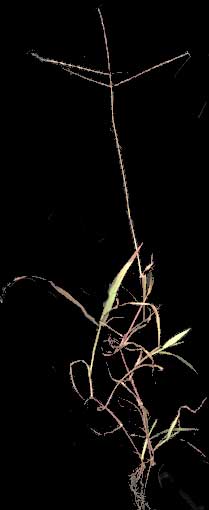Excerpts from Jim Conrad's
Naturalist Newsletter
page from Jim's BackyardNature.Net website, written around 2004 in the summer, in the woods near Natchez, Mississippi, USA
CRABGRASS
 If you live a city or in the suburbs, the most commonly encountered, wild-growing grass you may run into is Crabgrass, shown at the right. Its main identification features are that its flowers are arranged in very slender "fingers" (actually spike-like racemes) arising from the very top of the flowering stem. At the right you see four such racemes, but there can be fewer or more. Also notice how the main stem of the plant is so spindly that it leans onto the ground, often rooting along the stem.
If you live a city or in the suburbs, the most commonly encountered, wild-growing grass you may run into is Crabgrass, shown at the right. Its main identification features are that its flowers are arranged in very slender "fingers" (actually spike-like racemes) arising from the very top of the flowering stem. At the right you see four such racemes, but there can be fewer or more. Also notice how the main stem of the plant is so spindly that it leans onto the ground, often rooting along the stem.
People who want uniformly green lawns don't like crabgrass because with the first frosts it dies back, leaving large, brownish patches in the lawn. Not all grasses with slender racemes or spikes arising at the top are crabgrasses. Bermuda Grass, Goosegrass, Fingergrass, Carpet Grass and more do the same thing. To distinguish them you need to pay attention to technical details.
 Several species of crabgrass are known. The one at the right is the most common and is usually just called Crabgrass. It is Digitaria sanguinalis. Smooth Crabgrass is also a common lawn weed in northern states. The best way to distinguish these two common species is to see if the parts of the leaves wrapping around the stems (the sheathes) are hairy, as they are in Crabgrass (shown in the picture at the left), or hairless, as they are in Smooth Crabgrass.
Several species of crabgrass are known. The one at the right is the most common and is usually just called Crabgrass. It is Digitaria sanguinalis. Smooth Crabgrass is also a common lawn weed in northern states. The best way to distinguish these two common species is to see if the parts of the leaves wrapping around the stems (the sheathes) are hairy, as they are in Crabgrass (shown in the picture at the left), or hairless, as they are in Smooth Crabgrass.
 The feature that separates the various species of crabgrass from similar kinds of grass is the way the flowers are arranged on the slender racemes. At the left you see a much-magnified close-up of a small section of raceme. At the right in the picture at the left you see three florets, each containing a mature fruit. Each floret is about 1/8th-inch long (3 mm). At the left in the same picture is another raceme section but here the florets have fallen off, leaving only the old "flower stems," or pedicels. Note how the flowers and pedicels zigzag. One flower will arise to the right of the center of the raceme, then the one above it will arise from the left, then the right, then the left...
The feature that separates the various species of crabgrass from similar kinds of grass is the way the flowers are arranged on the slender racemes. At the left you see a much-magnified close-up of a small section of raceme. At the right in the picture at the left you see three florets, each containing a mature fruit. Each floret is about 1/8th-inch long (3 mm). At the left in the same picture is another raceme section but here the florets have fallen off, leaving only the old "flower stems," or pedicels. Note how the flowers and pedicels zigzag. One flower will arise to the right of the center of the raceme, then the one above it will arise from the left, then the right, then the left...
 Among crabgrasses the slender stem-like thing from which the florets arise
(the rachis) is not round in cross-section, as in most grasses. In some crabgrasses it is more or less triangular in cross-section, but in regular Crabgrass it is almost T-shaped. It's said that Crabgrass's rachis is "winged," the
"wings" being the top of the T seen in the rachis's cross-section. In the picture above and to the left you can barely see the "wall" between the two rows of florets. That "wall" is the bottom of the T. At the right the view is looking down onto the top of a Crabgrass's "winged rachis." You can see two pedicels peeping out from below the wings, one on the right and the other on the left. The pedicels have lost their matured florets.
Among crabgrasses the slender stem-like thing from which the florets arise
(the rachis) is not round in cross-section, as in most grasses. In some crabgrasses it is more or less triangular in cross-section, but in regular Crabgrass it is almost T-shaped. It's said that Crabgrass's rachis is "winged," the
"wings" being the top of the T seen in the rachis's cross-section. In the picture above and to the left you can barely see the "wall" between the two rows of florets. That "wall" is the bottom of the T. At the right the view is looking down onto the top of a Crabgrass's "winged rachis." You can see two pedicels peeping out from below the wings, one on the right and the other on the left. The pedicels have lost their matured florets.